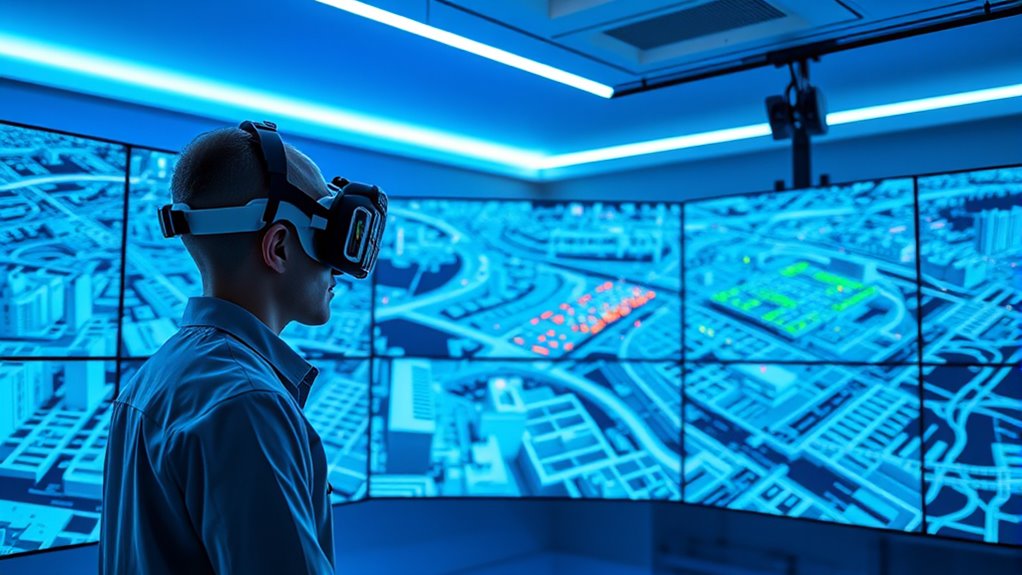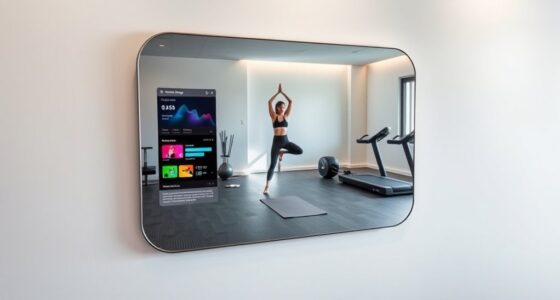AR cloud mapping standards and protocols guarantee your devices can share and interpret spatial data securely across environments. They define data formats, communication methods, and hardware compatibility, making certain your AR experiences are seamless and reliable. Privacy protections like encryption and user consent are vital to build trust and keep sensitive information safe. If you want to understand how these protocols create a connected, safe AR ecosystem, there’s more to explore ahead.
Key Takeaways
- Standards define data formats, encryption, and anonymization to ensure privacy and secure sharing of spatial mapping information.
- Protocols establish interoperability across devices, enabling consistent recognition and interaction within shared AR environments.
- Privacy guidelines emphasize user consent, transparent data policies, and protection against unauthorized access or breaches.
- Hardware compatibility protocols ensure seamless integration of sensors, cameras, and processors across different AR devices.
- Industry-wide standards promote scalability, security, and reliability, fostering a unified and trustworthy AR cloud ecosystem.

Have you ever wondered how augmented reality experiences seamlessly blend with the real world? It’s a fascinating process that relies heavily on precise mapping of physical spaces, known as AR cloud mapping. This technology creates a shared digital layer over real environments, allowing multiple devices to recognize and interact with the same physical points. But as you explore this world, you’ll quickly realize that establishing robust standards and protocols is essential for smooth operation, especially when it comes to privacy concerns and hardware integration.
One of the biggest challenges is guaranteeing that AR cloud mapping respects user privacy. As AR devices collect detailed spatial data, they gather information about your surroundings, which could include private spaces or sensitive details. To prevent misuse, standards need to define strict data handling protocols, such as encryption and anonymization. You want to be confident that your data isn’t vulnerable to breaches or unauthorized access. Privacy concerns also emphasize the importance of user consent and transparent data policies, so you’re aware of what’s being collected and how it’s used. Developing these standards requires collaboration among developers, industry leaders, and regulators to create a trusted ecosystem where users feel safe using AR applications.
Ensuring AR privacy through strict data protocols and transparent policies is essential for user trust and safety.
Hardware integration is another critical aspect that influences how effectively AR cloud mapping works across different devices. You’ll find that for AR experiences to be consistent and reliable, hardware components like cameras, sensors, and processors must work seamlessly together. Standards need to specify compatibility requirements so that AR devices from various manufacturers can share and interpret spatial data accurately. This ensures that whether you’re using a smartphone, smart glasses, or a dedicated AR headset, the mapping data aligns perfectly, providing a smooth, immersive experience. Without clear protocols, hardware differences could lead to inconsistent spatial recognition, lag, or inaccuracies that frustrate users.
To establish these standards, organizations and industry groups are working on protocols that address data formats, communication methods, and hardware capabilities. These guidelines aim to make AR cloud mapping interoperable, scalable, and secure. As you explore AR applications, you’ll notice that these standards help maintain consistency across devices and environments, making the technology more accessible and dependable. By prioritizing privacy and guaranteeing hardware integration through well-defined protocols, the industry moves closer to creating a unified AR ecosystem where experiences are seamless, safe, and reliable. Ultimately, these efforts will shape the future of AR, making it an integral part of everyday life while safeguarding your privacy and enhancing device compatibility.
Implementing these performance metrics ensures that AR systems operate efficiently and effectively, contributing to a more reliable user experience.
Frequently Asked Questions
How Does AR Cloud Mapping Impact User Privacy?
You might wonder how AR cloud mapping impacts your privacy. It can collect detailed data about your surroundings and movements, risking your data privacy if not properly protected. That’s why user consent is vital—you’re in control of what info you share. When standards and protocols are in place, they help guarantee your data is handled responsibly, giving you confidence and safeguarding your privacy while enjoying augmented reality experiences.
What Industries Benefit Most From AR Cloud Standards?
You’ll find that industries like retail, manufacturing, and healthcare benefit massively from AR cloud standards. These protocols ensure seamless data interoperability across AR hardware, making experiences smoother and more reliable. Imagine turning complex processes into effortless tasks—standards unify technology, boosting efficiency and innovation. By streamlining data exchange, these industries can create immersive, precise AR applications that transform how you work and shop, leading to a future where AR becomes an everyday essential.
ARe There Open-Source Protocols for AR Cloud Mapping?
You might wonder if open-source protocols exist for AR cloud mapping. Yes, there are some that promote mapping interoperability, like OpenARCloud and Mapbox SDKs, which help developers share data and improve compatibility. These open-source solutions enable you to build more seamless AR experiences across different platforms. While not as exhaustive as formal standards, they foster collaboration and innovation in AR cloud mapping, making it easier for your projects to integrate and scale.
How Do Cross-Platform AR Experiences Synchronize Data?
Think of your AR experience as a well-choreographed dance, where every move needs to sync perfectly. To accomplish this, developers use real-time synchronization techniques that guarantee data stays consistent across devices. Cross-platform compatibility is key, enabling your AR app to work seamlessly on different operating systems. By leveraging these methods, users enjoy smooth, cohesive experiences, no matter what device they’re on—like a symphony playing in perfect harmony.
What ARe Future Trends in AR Cloud Mapping Development?
You’ll see future trends in augmented reality focus on enhanced spatial mapping, making experiences more seamless and precise. As technology advances, expect better integration of AI for real-time environment understanding and improved cloud-based data sharing. These developments will enable more accurate, persistent AR experiences across devices, boosting collaboration and personalization. Overall, the evolution will make spatial mapping faster, smarter, and more accessible, pushing AR into everyday applications.
Conclusion
As you navigate the domain of AR cloud mapping, remember that standards and protocols are the compass guiding your journey. They’re the threads weaving a seamless tapestry of shared data and immersive experiences. Without them, the landscape becomes a fragmented mosaic. Embrace these frameworks, for they turn chaos into clarity, transforming raw data into a vibrant, interconnected world you can truly explore. After all, isn’t a map only as good as the path it reveals?









